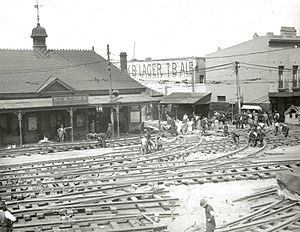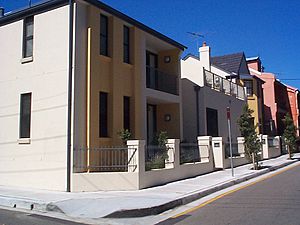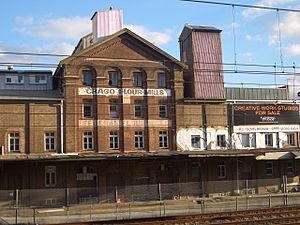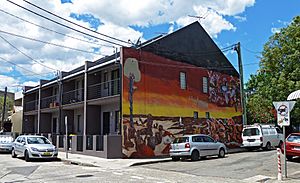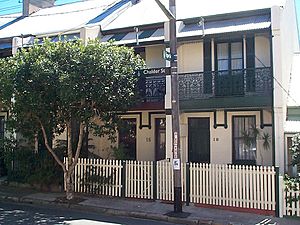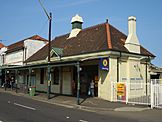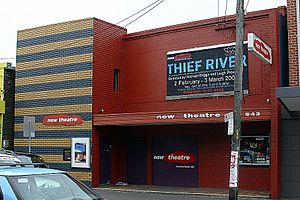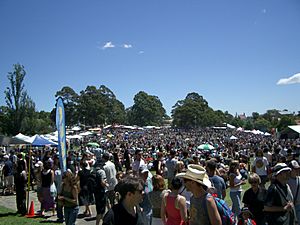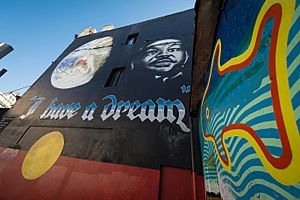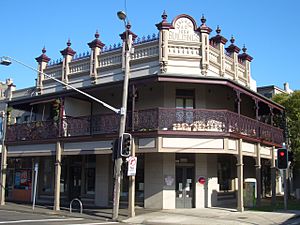Newtown, New South Wales facts for kids
Quick facts for kids NewtownSydney, New South Wales |
|||||||||||||||
|---|---|---|---|---|---|---|---|---|---|---|---|---|---|---|---|
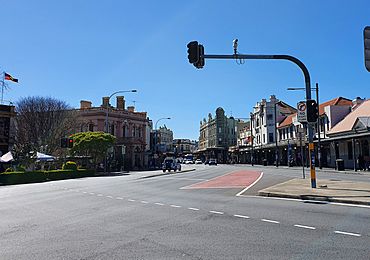
Intersection of King Street & Enmore Road, Newtown
|
|||||||||||||||
| Established | 1812 | ||||||||||||||
| Postcode(s) | 2042 | ||||||||||||||
| Elevation | 42 m (138 ft) | ||||||||||||||
| Area | 1.6 km2 (0.6 sq mi) | ||||||||||||||
| Location | 4 km (2 mi) south-west of Sydney central business district | ||||||||||||||
| LGA(s) |
|
||||||||||||||
| State electorate(s) | Newtown | ||||||||||||||
| Federal Division(s) | |||||||||||||||
|
|||||||||||||||
Newtown is a lively suburb in Sydney's inner west, Australia. It's about four kilometres south-west of the Sydney central business district (the city centre). Newtown is special because it sits across two different local government areas: the City of Sydney and the Inner West Council.
King Street is the main street in Newtown. It's a busy hub for shops, cafes, and fun activities. This street runs along a long ridge that starts near the University of Sydney and goes south, eventually becoming the Princes Highway.
Enmore Road branches off King Street near Newtown Bridge. This road goes over the Main Suburban railway line right by Newtown railway station. Together, Enmore Road and King Street have over 600 shops! This makes them one of the longest and most complete shopping areas from the late Victorian and Federation times in Australia.
King Street is often called "Eat Street" because it has so many cafes, restaurants, and places to eat from different cultures. You can also find cafes, restaurants, and art galleries on the smaller streets around King Street.
Contents
History
Aboriginal History
The land where Newtown is today was once home to the Cadigal tribe. They were part of the Eora people, who lived across a wide area from Sydney Harbour to Botany Bay and Petersham.
An 11-year-old Indigenous Australian boy named Tommy was the first to receive a Christian burial in the area. He was buried in Camperdown Cemetery. In 1944, a stone monument was put up in the cemetery to remember Tommy and three other Indigenous Australians buried there: Mogo, William Perry, and Mandelin (Aboriginal).
King Street, Newtown's main street, is believed to follow an old Aboriginal pathway. This path branched off a main western track (now Broadway and Parramatta Road) and continued all the way to the coast near Botany Bay.
The 19th Century
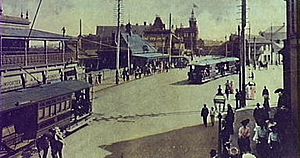
Newtown started as a place for homes and farms in the early 1800s. Nicholas Devine, a superintendent of convicts, named his property Burren Farm. This farm later became parts of Newtown and Macdonaldtown (now Erskineville).
Some stories say Newtown got its name from a grocery store opened by John and Margaret Webster in 1832. They put a sign on their store that said "New Town Stores." Another idea is that it was named after "Newtown House," built by Captain Sylvester John Browne around the same time. The name "New Town" became popular, and eventually, the space disappeared, making it "Newtown." However, some historians say the name was used even before Webster's store opened.
The southern part of Newtown was originally part of two land grants given to Nicholas Devine in the late 1700s. In 1827, this land was sold and then divided into smaller plots for housing. This is why you see many rows of terrace houses and old shops in Newtown today.
Part of Newtown, north of King Street, was once part of Camperdown. This area was named by Governor William Bligh in 1806. In 1848, some of this land was used to create Camperdown Cemetery. This cemetery became very important to the suburb. Between 1849 and 1868, about 15,000 people were buried there. Today, Camperdown Cemetery is smaller but still a lovely green space in Newtown. It has old trees and the Cemetery Lodge. Famous people buried there include explorer Sir Thomas Livingstone Mitchell and Major Edmund Lockyer.
From 1845, many churches were built in Newtown, including St Stephen's Anglican Church and St Joseph's Roman Catholic Church. The current St Stephen's Anglican Church, built between 1871 and 1880, is a beautiful example of Victorian Gothic architecture. Both the church and the cemetery are important historical sites.
On December 12, 1862, the Municipality of Newtown was officially formed. It covered about 480 acres.
Housing in the 19th Century
Newtown grew very quickly in the late 1800s. Many large farms and properties were divided into smaller lots for "terrace houses." These homes often have Victorian-era designs with decorated fronts, iron balconies, and fancy details. Many streets in Newtown look similar to other old Sydney suburbs like Glebe and Paddington.
Most of Newtown's residents lived in these terrace houses. Many were small, with two rooms upstairs and two downstairs, plus a kitchen at the back. Some had thin walls and shared roof spaces. Hundreds of these houses, often about 4 metres wide, are still standing. Builders sometimes put a slightly wider house on the corner of a street, which would be a shop. During the Federation period, single-story terrace houses also became common.
These small houses show that most Newtown residents were working-class people. They often worked in the city or at local shops, factories, and workshops like the Eveleigh Railway Workshops. Newtown became a busy place for retail and services. By the early 1900s, Newtown was described as "one of the most wealthy suburbs around Sydney."
Some grand Victorian mansions were built on larger estates, and there were also fancier terrace houses in areas like Georgina Street. Sadly, some of the biggest and most important houses, like "Erskine Villa," were pulled down to make way for more housing.
From the late 1800s, Newtown became a major centre for business and industry. King Street became a busy shopping area, and factories, workshops, and warehouses appeared throughout the suburb. Big industries in the wider Newtown area included the Eveleigh Railway Workshops, the IXL jam factory, and the St Peters brickworks.
Public Housing
Newtown has some public housing areas built from the late 1960s to the 1970s. These often include apartment blocks and townhouses built close together. These homes are for social housing tenants.
Many of these complexes were built using a design called "Radburn principles." This means they have shared pathways and courtyards separated from roads. Homes in these areas are owned by the Department of Housing or the Aboriginal Housing Office.
Department of Housing sites in Newtown:
- 8 prefabricated terraces, 7 walk-up flats on Alice Street/Camden Street.
- 9 prefabricated walk-up flats on Alice Street/Hawken Street corner.
- 13 prefabricated walk-up flats, 1 six-story tower block on Forbes Street/Golden Grove Street/Darlington Road.
- 1 nine-story tower block, plus Victorian terrace houses on Station Street/Reiby Lane corner.
There are also many other Victorian terrace houses and walk-up flats scattered around the suburb.
Early 20th Century
Even though Newtown was prosperous in the late 1800s, it became less wealthy during the first half of the 1900s, especially during the Great Depression. Many inner-city Sydney suburbs like Glebe also faced similar changes. In 1949, Newtown became part of the City of Sydney.
Mid-20th Century
Newtown was once a fairly wealthy suburb, which is why you can still see many grand Victorian mansions there. However, over time, many parts of Newtown became a place where working-class families lived. After World War II, low rents and house prices attracted new migrants from Europe, changing Newtown's population.
In the 1970s, as families moved to outer suburbs, many relatively cheap terrace houses became available for rent. Because Newtown is close to the University of Sydney and the city centre, it started to attract university students in the 1960s and 1970s. The area became a popular place for students to share houses. The growth of cafes, restaurants, and entertainment venues made it a popular spot for many young people. Newtown gained a reputation as a creative and artistic centre.
Late 20th Century and Early 21st Century
The 1980s was a time of great variety in Newtown, with affordable housing still available. In the 1990s, many old businesses closed, like Brennan's Department Store, which had been there since the 1800s.
Many homes have been restored and show off the beautiful 19th-century architecture of Sydney. Like other inner-Sydney suburbs, Newtown has seen changes where wealthier people have moved in, improving the area. From the 1970s onwards, many large industrial and commercial sites in the area closed. Some of these old buildings have been turned into homes, like the Alpha House and Beta House apartment complexes on King Street, which used to be multi-story warehouses. Before becoming apartments, these buildings were artist warehouses where many performing arts companies started.
Heritage Listings
Newtown has several places listed for their historical importance:
- 187–189 Church Street: St Stephen's Anglican Church
- 15 Carillon Avenue: The Women's College building
- Great Southern and Western railway: Newtown railway station and Newtown Tram Depot
- 69–77 King Street: Trocadero
- 280a King Street: Newtown Mission Uniting Church
Transport
Rail
Newtown railway station is part of the Sydney Trains network, on the Leppington & Inner West Line and Liverpool & Inner West Line. The station opened in 1855. It was one of the first four stations on the railway line from Sydney to Parramatta. In 1878, the station moved to its current spot near King Street and Enmore Road.
Until the 1960s, when trams were stopped in Sydney, Newtown was a major place for changing between trains and trams. Several tram services were based there, and the old Newtown Tram Depot still stands next to the station. The old office buildings of the tram depot were renovated in 2012 and now house a cafe and restaurant. This renovation also made it easier for people to get to the station platforms, adding stairs and an elevator for disabled access.
Buses
Transdev John Holland and Transit Systems operate buses through Newtown. Buses replaced the old tram services and follow similar routes along King Street and Enmore Road. These buses go towards the city and outwards to suburbs like Tempe, Dulwich Hill, and Canterbury. There are also services that go east to Bondi Junction and north to the University of Sydney and south-east to the University of New South Wales and Coogee.
Education
In the 1990s, Newtown High School was chosen to become a special performing arts high school. It was renamed Newtown High School of the Performing Arts. This school combines regular school subjects with education in music and theatre. Before this, it was Newtown Junior Technical School for boys.
Primary and infants schools in the area include:
- Australia Street Infants School
- Bridge Road School, Camperdown
- Camdenville Public School
- Newtown Public School
- North Newtown Public School
Private schools in the area include the Athena School.
The University of Sydney's Centre for Continuing Education offers classes for adults.
Landmarks
Historic Buildings
Newtown has many historic buildings, some of which were once popular gathering places. These include several from the late Victorian era and some in the Art Deco style from the mid-20th century. For example, "The Marlborough" building is known for its commanding appearance at a wide intersection of King Street and Missenden Road.
The Trocadero

One important building that has been restored in Newtown is the Trocadero dance hall on King Street North. This large entertainment venue opened in 1889 and is one of the last 19th-century dance halls still standing in Sydney. Over the years, it was used as a dance hall, a skating rink, a cinema, a boxing and vaudeville venue, a bicycle factory, and a motor body works.
Since 1920, it was owned by the Grace Bros retail company. For many years, a Lebanese restaurant was located on the northern side of the building. In 1974, Moore Theological College bought the building. From 1981 to 1994, it housed a used furniture store. Luckily, a careful restoration project between 2005 and 2006 by Moore College brought this amazing 19th-century building back to its original beauty, including its fancy Flemish-style front.
Burland Hall
Another Newtown landmark that has changed a lot is the site of the former Burland Community Hall on King Street. In the early 1900s, it was the original Hub Theatre. From the mid-1900s, it was an Art Deco-style cinema run by Hoyts. In the mid-1960s, the cinema became a community hall and was renamed Burland Community Hall in 1965. For years, it hosted community events like dances, concerts, film screenings, and markets. In 1986, the City of Sydney Library moved its Newtown branch to the upper floor. In 1995, the library moved again, and Burland Hall was redeveloped into offices and shops.
Hub Theatre
The Hub Theatre, located opposite Newtown Station next to the old Newtown Town Hall, is a notable landmark. The original Hub was elsewhere before moving to its current spot, which was once a vaudeville theatre. It became a cinema in the 1930s. More recently, the Hub has hosted live comedy shows and other performances, bringing new life to the building.
Culture
Live Music
Newtown has been a centre for live entertainment since the late 1800s. In the 1980s, many venues in the area had a thriving live music scene, especially the Sandringham Hotel. One famous Australian band, The Whitlams, often performed there. Musician John Kennedy wrote a song called "King Street" in the mid-1980s, mentioning familiar Newtown places and people.
Throughout the 1990s, Newtown was known for indie rock music, with many musicians living there and several live venues. After some venues closed, live music returned to the Sandringham Hotel in 2005. In 2014, it reopened as the Newtown Social Club, hosting music upstairs. However, in 2017, it closed and reopened as Holey Moley, a mini-golf course. Another newer live music spot in Newtown is Leadbelly (formerly The Vanguard) at the north end of King Street. The Enmore Theatre also remains a popular venue for concerts.
Theatre
Newtown and its nearby areas have the most independent theatres and live performance spaces in Sydney. Theatres currently operating include:
- New Theatre, which started in 1932 and is Australia's oldest continuously performing theatre.
- Enmore Theatre on Enmore Road.
- The Newtown High School of the Performing Arts.
In the 1970s and 1980s, many theatres and cinemas in Sydney's city centre were pulled down. Because there weren't many medium-sized venues left, the Enmore Theatre became one of the busiest concert venues in Sydney.
In the 1800s and early 1900s, Newtown had several popular theatres. Some of their buildings are still standing, while others have been demolished. The Trocadero hosted theatre and vaudeville shows. The Hub, originally called Clay’s Bridge Theatre, opened in 1913 and staged vaudeville acts. Other theatres from this time included Fullers' Majestic Theatre (later the Elizabethan Theatre) and St George's Hall.
Festivals
Newtown hosts several yearly festivals.
The Newtown Festival was a community event with free live music, activities, workshops, and stalls. It was held every year from 1978 to 2019 in Camperdown Memorial Park. The festival raised money for the Newtown Neighbourhood Centre, which helps people who don't speak English, the elderly, people with disabilities, or those in need.
Feastability, Newtown's Food and Wine Festival, shows off the suburb's many international foods, Australian wines, local businesses, and bakers. This festival started in the mid-1990s and now takes place at the Newtown School of Performing Arts. It has over 40 stalls, all-day entertainment, and activities for kids. The Marrickville Council organizes the festival.
The Under the Blue Moon Festival was another community festival held in September. It featured live music, discussions, street performances, fashion shows, and other presentations, often from alternative subcultures.
The Sydney Fringe festival is a three-week arts festival that started in September 2010. It takes place at venues in Newtown, Enmore, and Marrickville.
Sport
The Newtown Rugby League Football Club, known as the "Newtown Jets," is Australia's oldest existing rugby league club. It was formed in 1908 at the Newtown Town Hall. They play in the NSW Cup competition, which is one level below the NRL. Their home ground is Henson Park in Marrickville.
Film and Television
In the late 1960s, the Australian TV drama You Can't See Round Corners was set in Newtown. The Spanish Mission-style service station on King Street was used in the 1985 film Bliss.
Erskineville Kings (1999) used many locations in Newtown and Erskineville. Garage Days (2002) is about a fictional indie rock band based in Newtown. The ABC TV drama Love Is a Four Letter Word filmed scenes at the Courthouse Hotel.
St Stephen's Church and Camperdown Cemetery have often been used for filming movies, TV shows, and music videos, including Priscilla, Queen of the Desert.
The 2012 romantic comedy Not Suitable for Children was filmed in Newtown. In 2013, the Sydney band Sticky Fingers filmed their music video for "Australia Street" on King Street. In 2014, the British band Coldplay featured Newtown in their music video for "A Sky Full Of Stars".
Literature
Writers and Libraries
Many important writers have lived or live in Newtown, including Rolfe Boldrewood, Henry Lawson, Henry Kendall, Ethel Turner, Nadia Wheatley, and David Malouf. The composer and writer Isaac Nathan is buried at Camperdown cemetery.
The first public library in New South Wales was set up in Newtown in 1868. Today, Newtown has the Newtown Library (run by the City of Sydney) and The Women's Library, which focuses on feminist topics.
Newtown is home to many bookshops, like Gould's Book Arcade (started in 1967), Better Read than Dead, and Elizabeth's Bookshop. The Anarchist bookshop Black Rose Books has been in Newtown since 1982.
Many publishing houses have also been active in Newtown. Walker Books and Sydney University Press are currently based in the area. The Newtown Review of Books, a literary magazine, started in 2012.
Newtown in Stories
One of the first stories published in colonial Sydney was "The Legend of Newtown" by D.H. Deneihy in 1845. It described Newtown as a "favourite place" for fresh air and rural views.
The famous Newtown recluse Eliza Emily Donnithorne (1826–1886) is said by some to have inspired the character of Miss Havisham in Charles Dickens' novel Great Expectations. Donnithorne lived on King Street and is buried at Camperdown cemetery.
Dorothy Hewett's 1959 novel Bobbin' Up describes the dance halls and nightlife of King Street in the 1950s. The House that Was Eureka by Nadia Wheatley (1985) is set in Newtown terrace houses during times of economic hardship.
More recent novels set in Newtown include The Bird's Child by Sandra Leigh Price (2015), Dark Fires Shall Burn by Anna Westbrook (2016), and the verse novel Newtown Voices by Sue Cartledge (2017).
Newtown in Poetry
Many poems have been written about Newtown, including "Laminex" by John Tranter, "Newtown Pastoral" by Gig Ryan, and "King Street Newtown" by Alison Clark. The 1994 collection Wildlife in Newtown is by Colleen Burke.
Newtown in Children's Books
Children's books set in Newtown include My Place and Five Times Dizzy and Dancing in the Anzac Deli by Nadia Wheatley, and Lara of Newtown by Chris McKimmie.
Graffiti and Street Art
Newtown is also known for its creative graffiti and "street art." The most famous works are large murals painted on the walls of houses and shops in the late 1980s and early 1990s. More recently, the style of spray-painted "tags" has become more detailed.
Examples include a mural of American civil rights leader Martin Luther King Jr. on King Street (painted by Andrew Aiken and Juilee Pryor), the "Great Wave" mural in Gowrie Street, and the "Three Proud People" mural (a copy of a famous photo from the 1968 Mexico City Olympics).
Since 2014, the Inner West Council has run the "Perfect Match" program. This program connects artists with residents and business owners to create large paintings in public spaces. Over 160 artworks have been made through this program in Newtown and other areas.
Population
| Historical population | ||
|---|---|---|
| Year | Pop. | ±% |
| 2001 | 12,457 | — |
| 2006 | 13,550 | +8.8% |
| 2011 | 14,148 | +4.4% |
| 2016 | 15,029 | +6.2% |
| 2021 | 14,690 | −2.3% |
Demographics
At the 2021 census, there were 14,690 people living in Newtown.
Newtown has a younger population, with an average age of 33, which is younger than the national average of 38.5. Many residents in Newtown have a high level of education, with 41.1% having a bachelor's degree or higher.
Newtown is also known for its diverse cultures. About 28.2% of residents speak a language other than English at home, showing the multicultural nature of this inner-city suburb.
According to the 2021 Census, most Newtown residents (64.5%) were born in Australia. Other countries of birth include England (5.7%), New Zealand (2.7%), China (1.5%), and the USA (1.4%). People from many different backgrounds live in Newtown, making it a mix of global cultures within Sydney.
Newtown residents generally have a good lifestyle, with a median weekly household income of $2,024, which is higher than the national average. The suburb continues to attract students, professionals, artists, and independent thinkers, making it one of Sydney's most dynamic and unique suburbs.
Notable Residents
Many interesting people have lived in Newtown, including:
- Christine Anu (b. 1970), a pop singer.
- Sarah Blasko, a musician.
- Rolf Boldrewood (1826–1915), author of Robbery Under Arms.
- Murray Cook (b. 1960), a member of The Wiggles.
- Eliza Emily Donnithorne (c.1826–1886), a famous recluse.
- John Villiers Farrow (1904–1963), an Academy Award-winning film director.
- Lilian Fowler (1886–1954), Australia's first female Mayor.
- Frenzal Rhomb, a band that started in Newtown.
- Nicholas Harding, an Archibald Prize-winning artist.
- Henry Lawson (1867–1922), a famous writer.
- Mary Reibey (1777–1855), a pioneering businesswoman featured on the Australian twenty-dollar note.
- Adam Spencer, a mathematician and TV personality.
- Nadia Wheatley, a writer.
- The Whitlams, a pop band.
- Youth Group, an indie rock band.
Governance
Local Government
Newtown is split between two local government areas: the Inner West Council and the City of Sydney.
State Government
| 2015 State Elections Newtown: First preference votes |
||
|---|---|---|
| Greens | 45.6% | |
| Labor | 30.8% | |
| Liberal | 17.8% | |
| Animal Justice | 2.2% | |
| Cyclists | 1.8% | |
Newtown is mainly in the State electoral district of Newtown. This district was created again before the 2015 NSW State Election, having existed before but being removed after the 1950 election.
Federal Government
Federally, Newtown is partly in the electorate of Division of Grayndler, represented by Anthony Albanese from the ALP. It is also partly in the electorate of Sydney, represented by Tanya Plibersek, also from the ALP.
Images for kids


